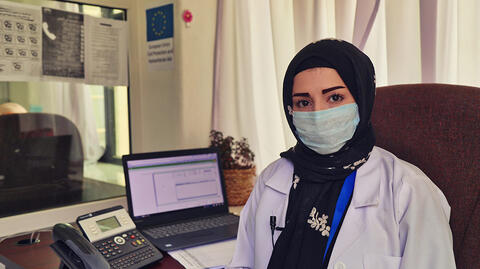News
2020 Year in Review: Top 5 stories affecting women and girls
- 28 December 2020
News
UNITED NATIONS, New York – It comes as no surprise that Merriam-Webster declared “pandemic” the word of the year. The biggest stories all stemmed from one story: COVID-19, a disease that affects the respiratory system, is transmitted by breath and fittingly surrounds us like air. It touched everyone on the planet in some way – a devastating shared fate.
But here’s another word that defined this difficult year: “resilience.” As 2020 draws to a close, we are highlighting not only ways the pandemic affected women and girls, but also how people around the world met challenge with determination, fear with courage, and despair with grace. Yes, the year was much about loss and lack and less. We have seen years of hard-won progress erased. But there was also innovation and solidarity and grit. As the year comes to an end and we look back on what was, we also look forward with a renewed sense of focus, hope and ambition. Here’s why.
The pandemic pitfall: Between lockdown measures, financial pressures, and fear of contracting the virus at health care facilities, pregnant women faced reduced access to health services.
The pivot: El Salvador instituted telemedicine; and in a world where front-line health care workers – some lacking personal protective equipment (PPE) – became heroes, midwives in Afghanistan, Haiti, Bangladesh and Iran among other countries put their lives at risk to provide maternal care. UNFPA programmes around the world also ramped up distribution of PPE for health workers and sanitizers and masks for patients.

The pandemic pitfall: With mandatory shelter-in-place orders around the globe, women were forcibly trapped with their abusers. UNFPA sounded the alarm on this shadow pandemic of a spike in gender-based violence, estimating in April that six months of lockdowns could lead to 31 million additional cases of violence, and an additional 15 million more cases for every three months the lockdown continued.
The pivot: As access to shelters and in-person counselling was restricted, UNFPA and its partners sought virtual solutions, from increasing tele-counselling services in Bhutan, Yemen and Mongolia to introducing silent platforms like Viber and Messenger in Ukraine.
The pandemic pitfall: Because of support service disruptions and the economic fallout of COVID-19, 13 million extra child marriages are predicted in the years ahead. Remote learning isn’t feasible for all children, and when schools reopen, girls may not return if their financially strapped families choose to educate only their sons. In some cases, girls will be married off as a source of income for her family or because she is seen as a financial burden.
The pivot: In-person life skills programmes to empower adolescent girls and raise their status in society were curtailed by pandemic restrictions, so these messages shifted to radio (Nepal, Uganda, Ghana, Yemen) and television (Mozambique). Social media and messaging services like WhatsApp became main communication channels in a number of countries in the UNFPA-UNICEF Global Programme to End Child Marriage. Helplines, which have seen an uptick in calls seeking assistance, are being used as a prevention strategy.

The pandemic pitfall: Lockdown measures, health facility slowdowns, supply chain disruptions and product shortages all hampered women’s access to family planning methods. Seven out of 10 countries experienced disruptions in contraceptive services, according to a World Health Organization survey. UNFPA and partners estimated that six months of lockdowns could result in 47 million women unable to access contraceptives. The potential fallout: 7 million unintended pregnancies, which could lead to pregnancy complications, maternal and child death, and unsafe abortions among other consequences. For every three months of continued lockdown, an additional 2 million may not be able to use contraceptives.
The pivot: Outreach workers in Egypt called women to make sure they kept family planning on track, whether that meant giving them a greater supply of oral contraceptives or offering longer-acting methods such as implants effective for two to three years or IUDs for 10 to 12. From turning quarantine centres into family planning centres in Nepal, to deploying messaging services to address family planning needs in Eswatini, to using ride-hailing services to deliver contraceptives in Uganda – all were examples of necessity being the mother of invention.
The pandemic pitfall: Shrinking economies could divert national budgets from women and girls’ issues to battling the pandemic.
The pivot: There hasn’t been one. Rather than renege on the commitments they made at the Nairobi Summit in November 2019, donors either met or surpassed them, sending a resounding message that the health and well-being of women and girls are non-negotiable. Governments, corporations, organizations, NGOs, and individuals didn’t use COVID-19 as cover to shirk its responsibilities. Congo, for example, launched an emergency obstetric care initiative in August. An investment in women and girls is an investment in our collective future; a promise to them is a promise to ourselves.